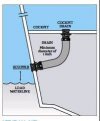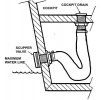Mustang, I don't mean this in a negative way, so keep that in mind... you're welcome to disagree, but you would be wrong. Stagnant water is not the same as still water. See the comments about O2. My, and other's, comments often come from years and years of experience and even from being in the marine industry for decades - not just googling

The smilie face is there to make sure you know I'm keeping this conversation "light hearted".
Although I wouldn't necessarily trust the opinion of someone trying to sell their product, as I've previously mentioned, this is more about "best practice". Bronze IS better. That is fact. That's not to say that (as I also mentioned before) SS is going to magically disappear - it won't. It's just something to keep a closer eye on till you get a comfort level with it.
You mentioned this in post #18 earlier "I honestly don't know how well the SS would fair (or not fair). It's probably not (well, definitely not) something I would personally take a chance on. SS is also not "officially" approved for below the waterline. It's pretty well known in the marine industry that it's a no-go for SS. I don't know the answer, but if the boat sank due to a failed fitting... would the insurance company deny coverage due to installation of an unapproved item? There's nothing really "wrong" with rubber flappers - they do the job - you just have to change them when they get old and stiff"....
But now you seem to have changed your mind going from earlier when you admitted not knowing "how well the SS would fair" to now talking about all of the experience you have "from being in the marine industry for decades - not just googling

". My frustration with the topic at hand is that it seems like a lot of conjecture, worth of mouth or "what if" statements. It's like on the Vintage Mustang forum website that I'm also a part of where guys say you can't run a 650 cfm carburetor on a small block Ford and that you have to run a bigger carburetor, fuel lines and/or fuel pump because that's what their buddy told them, or that's what their buddy runs or what someone else told them years and years ago. The 351w motor in my 1965 fastback with 450 hp only has a 650 cfm Holley carburetor on it, which I was told I was crazy for running that small of a carburetor on my engine. Same with a smaller 80 gph Holley fuel pump and the stock 5/16" fuel line. Guys on there said I need a bigger fuel line, fuel pump and carburetor to run the motor that I've got, yet I've been doing it successfully and without any problems for years. Funny thing is, the guys who say you need to run larger fuel pumps and larger fuel lines are also the ones needing a fuel pressure regulator because their carburetor is getting double the fuel pressure that it needs and because of that, it runs like crap. I think the same is true with regards to something like this on here where you're saying stainless steel won't work below the waterline or something that you wouldn't risk taking a chance on.
My thought process on the matter, and I didn't realize or think about this until recently, is that either I believe KY Grady or Smokey Mountain Grady mentioned in another thread that scuppers are for self bailing the water out of the cockpit. Considering the height of the deck is higher than the height of the scupper on the outside of the hull, and it looks essentially like a "J" or a snorkel for scuba diving, water shouldn't come in unless you're standing back there or have a ton of weight that is putting the deck height at the water level or under. So basically, unless your boat was taking on water from say not having a drain plug installed or it had a serious crack in it, then you shouldn't have water coming in from the ocean. And that is evidenced with my boat for example, where water won't come in from the scuppers unless myself and/or another person is standing back there, then it starts to pool in. I guess long story short, is that as I alluded to above, unless the deck height of your boat is at or lower than the water line, then water won't come in, whether it's a rubber/plastic scupper or whether it's stainless steel. The rubber flaps on my plastic scuppers are bent so that water will come in, as mentioned above, when I have myself and/or another person back there. But water doesn't come in when I don't have weight back there even if there's a gap in the rubber flapper, it's not air tight either way and some water will come in but because of gravity, it's not going to flow from sea level to the deck level magically or by itself. Long story short, a stainless steel scupper won't sink your boat by itself because of corrosion or the flapper staying open, it'll be from forgetting to put the drain plug in the boat or the boat taking on water from another source to where the level of the deck is now at the level of the water line and water can flow freely in. Which is why water will come in from your drain plug because it's underneath the water line and where it enters the boat is also equal to or less than where it's coming in from. Which is why if you don't have a drain plug in your boat then you'll sink, but if your rubber flappers on your scuppers don't seal correctly, your boat won't sink, at least from that alone, even if the scuppers are below the water line you'll still have some water in the tubes or pipes up until the bend in the "J" but it won't go past that point because of gravity and because the deck is still above the water line. My biggest issue is standing in the back of the boat with shoes on and getting your feet soaking wet, and I believe the Seaworthy Innovations scuppers will fix that issue. I think the majority of the time people have issues with scuppers is because they're jammed or clogged up with junk on the outside allowing the water in the cockpit to not successfully drain out, and not the other way around where you're getting too much water in from the outside for no reason. Good day.







